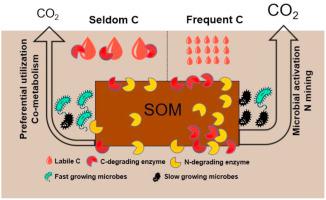Soil Biology and Biochemistry ( IF 9.7 ) Pub Date : 2020-11-11 , DOI: 10.1016/j.soilbio.2020.108069 Jie Zhou , Yuan Wen , Lingling Shi , Miles R. Marshall , Yakov Kuzyakov , Evgenia Blagodatskaya , Huadong Zang

|
Labile carbon (C) inputs to soil (e.g., litter and root exudation) can prime soil organic matter (SOM) decomposition, and strongly influence SOM dynamics. The direction and intensity of priming, as well as the net C balance in soil, depend on the amount and frequency of labile C inputs. Most recent priming studies are based on single C additions, which are not truly representative of common litter inputs or root exudation in terrestrial ecosystems. Here, we evaluated the effects of 14C-labeled glucose addition to soil in the same final amounts (360 μg C g−1) split into two temporal patterns: seldom (20% of microbial biomass every two months) and frequent addition (4% of microbial biomass every 10 days) on the dynamics of CO2 production and SOM priming over a 200-day incubation. For the first time, we combined enzyme kinetics with substrate-induced growth respiration and fungal diversity to monitor microbially mediated SOM mineralization in response to the labile C input frequency. Frequent glucose addition decreased 14C incorporation into microbial biomass and almost doubled cumulative priming compared to seldom addition, resulting in a net loss of SOM for seldom and frequent C additions of −94 and −367 μg C g−1 respectively. Larger priming loss of SOM with frequent C inputs was accompanied by increased activities of β-glucosidase, chitinase, and acid phosphatase, and by a shift in fungal community towards increased abundance of K-strategist fungal species (mainly Mortierellales sp. and Trichoderma sp.) capable of SOM mineralization. In conclusion, frequent labile C inputs (e.g., rhizodeposits in rhizosphere or litterfall in disturephere) to soil will stimulate a shift in fungal community structure and functions, resulting in intensive priming of SOM decomposition and CO2 losses.
中文翻译:

频繁输入不稳定碳引起土壤有机质的强烈启动
向土壤中输入的不稳定碳(C)(例如,凋落物和根系渗出物)可以引发土壤有机质(SOM)分解,并强烈影响SOM动力学。引发的方向和强度,以及土壤中的净碳平衡,取决于不稳定碳输入的数量和频率。最近的启动研究基于单碳添加,它们不能真正代表陆地生态系统中常见的凋落物输入或根系分泌物。在这里,我们评估了将14 C标记的葡萄糖以相同的最终量(360μgC g -1)添加到土壤中的效果,分为两个时间模式:很少(每两个月20%的微生物量)和频繁添加(4每10天微生物生物量的百分比)对CO 2动力学的影响在200天的孵化过程中进行生产和SOM启动。我们首次将酶动力学与底物诱导的生长呼吸和真菌多样性相结合,以监测微生物介导的SOM矿化,以响应不稳定的C输入频率。与很少添加相比,频繁添加葡萄糖减少了14 C掺入微生物生物量中,并使累积启动几乎增加了一倍,导致很少和频繁添加C的SOM净损失分别为-94和-367μgC g -1。频繁输入C导致SOM的更大的引发损失伴随着β-葡萄糖苷酶,几丁质酶和酸性磷酸酶活性的增加,以及真菌群落向K-策略家真菌物种丰富度增加的转变(主要是mortierellales sp。和木霉属。)能够SOM矿化。总之,频繁向土壤中不稳定的碳输入(例如,根际中的根状沉积物或菜地中的凋落物)将刺激真菌群落结构和功能的转变,从而导致SOM分解和CO 2损失大量引发。



























 京公网安备 11010802027423号
京公网安备 11010802027423号